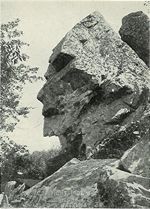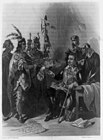Massasoit
Massasoit | |
|---|---|
| Ousamequin | |
 Sculpture of Ousamequin in Mill Creek Park, Kansas City, Missouri byCyrus E. Dallin | |
| Wampanoagleader | |
| Succeeded by | Wamsutta |
| Personal details | |
| Born | Ousamequin c. 1581 |
| Died | 1661 (aged 80) |
| Children | Wamsutta,Metacomet |

Massasoit Sachem(/ˌmæsəˈsɔɪ(ɪ)t/MASS-ə-SOYT,-SOY-it)[1][2]orOusamequin(c. 1581– 1661)[3]was thesachemor leader of theWampanoagconfederacy.MassasoitmeansGreat Sachem.Massasoit was not his name but a title. English colonists mistook Massasoit as his name and it stuck.[4]
Massasoit's people had been seriously weakened by a series of epidemics and were vulnerable to attacks by theNarragansetts,and he formed an alliance with the colonists atPlymouth Colonyfor defense against them. It was through his assistance that the Plymouth Colony avoided starvation during the early years.
English at Plymouth
[edit]At the time of the pilgrims' arrival in Plymouth, the realm of the Wampanoag, also known as thePokanokets,included parts ofRhode Islandand much of southeasternMassachusetts.[5]Massasoit lived in Sowams, a village atPokanoketinWarren, Rhode Island.He held the allegiance of lesser Pokanoket sachems. In 1621, he sentSquantoto live among the colonists at Plymouth.[6]
Outbreaks of an unidentified disease had devastated the Pokanokets, and Massasoit sought an alliance with the colonies ofNew Englandagainst the neighboring Narragansetts who controlled an area west ofNarragansett Bayin Rhode Island.Samosetwas a minor Abenaki sachem (sagamore) who hailed from theMuscongus Bayarea ofMaine,[7]and he learned to speak English from fishermen who plied those waters. Massasoit sent him to approach the colonists to find out whether their intentions were peaceful.
Massasoit forged critical political and personal ties with colonial leadersWilliam Bradford,Edward Winslow,Stephen Hopkins,John Carver,andMyles Standish,ties which grew out of apeace treatynegotiated on March 22, 1621. The alliance ensured that the Pokanokets remained neutral during thePequot Warin 1636.[8]According to English sources, Massasoit prevented the failure of Plymouth Colony and the starvation that thePilgrimsfaced during its earliest years.[8]
Lasting alliance
[edit]
Some tension continued between Massasoit and the colonists when they refused to give upSquanto,whom Massasoit believed to have betrayed him. This was resolved in March 1623 when Massasoit was gravely ill and Edward Winslow nursed him back to health.[9]After his recovery, Winslow reports that Massasoit said, "the English are my friends and love me... whilst I live I will never forget this kindness they have showed me."[10]In return for their kindness, Massasoit warned them of a plot against them. He had learned that a group of influentialMassachusettwarriors intended to destroy both theWessagussetand Plymouth colonies, and he warned the Pilgrims in time.

The alliance came under other tension in later years, as the colonists expanded into new lands in order to support their growing colony. Massasoit sold a tract of land 14 miles square to Myles Standish and others ofDuxburyin 1649 to alleviate tension and maintain the peace. The sale took place atopSachem Rock,an outcropping on theSatucket RiverinEast Bridgewater, Massachusetts.The site is listed on theNational Register of Historic Places.
Children
[edit]Massasoit had five children: sonWamsutta,who was born between 1621 and 1625; son Pometecomet,Metacomet,or Metacom; son Sonkanuchoo; and daughters Amie and Sarah. Soon after his death, Wamsutta and Metacomet went to Plymouth and asked the Pilgrims to give them English names. The court named them Alexander and Philip. Wamsutta, the eldest, becamesachemof thePokanoketson the death of his father.[11]He died within a year, and his brother Metacom succeeded him in 1662.[12]Amie married Tispaquin and was the only one of Massasoit's five children to surviveKing Philip's Warin 1676.
Legacy
[edit]This sectionneeds additional citations forverification.(March 2011) |
Roger Williamsfled theMassachusetts Bay Colonyto avoid arrest and deportation for religious reasons and stayed the winter of 1635–36 with Massasoit, who gave him land along theSeekonk Riverthe following spring. Governor Winslow advised Williams to move his settlement to the other side of the river because his current location was within the bounds of Plymouth Colony. Williams did so and foundedProvidence Plantations,which later became part of theColony of Rhode Island.[13]
The half century of peace that Massasoit so assiduously maintained collapsed soon after his death. Wamsutta broke away from his father's diplomacy and began an alliance withConnecticut Colony.
Massasoit was humane and honest, kept his word, and endeavored to imbue his people with a love of peace. He kept the Pilgrims advised of any warlike designs toward them by other tribes.[11]It is unclear when Massasoit died. Some accounts claim that it was as early as 1660; others contend that he died as late as 1662. He was anywhere from 80 to 90 at the time.[11]
Wamsutta died suddenly within a year of his succession, and Massasoit's second son Metacom became sachem of the Pokanokets and chief sachem of the Greater Wampanoag Confederacy. He believed that Wamsutta had been murdered at the hands of the Colonists, and this was one of the factors that led toKing Philip's War,one of the bloodiest wars in Colonial American history.
Astatue of Massasoitby sculptorCyrus E. Dallinstands nearPlymouth Rock,with othersoutside the Utah State Capitolbuilding, on the campus ofBrigham Young University,at theSpringville Museum of ArtinSpringville, Utah,and inKansas City, Missouriat the corner of Main Street and Emanuel Cleaver II Blvd. In Massachusetts, bothMassasoit Community CollegeandMassasoit State Park[14]are named for him.
Gallery
[edit]-
Meeting of Governor Carver and Massasoit
-
The Palace of Massasoit
-
Massasoit and his Warriors
See also
[edit]References
[edit]- ^"Massasoit".Merriam-Webster Dictionary.RetrievedFebruary 24,2021.
- ^"Massasoit Commercial - 30 Seconds".Massasoit Community College. February 25, 2020.RetrievedFebruary 25,2021.
- ^"Native People" (page), "Massasoit (Ousamequin) Sachem" (section),MayflowerFamilies,web page:MFcom-NativeArchivedNovember 4, 2006, at theWayback Machine
- ^Bicknell, p. 12
- ^Wright, Otis Olney, ed. (1917).History of Swansea, Massachusetts, 1667-1917.Town of Swansea. p. 19.OCLC1018149266.Retrieved11 June2018.
- ^Humins, John H. (March 1987). "Squanto and Massasoit: A Struggle for Power".New England Quarterly.60 (1): 54–70.doi:10.2307/365654.JSTOR 365654.
- ^Bradford, William (1952). Morison, Samuel Eliot (ed.).Of Plymouth Plantation, 1620–1647.New York: Alfred A. Knopf. p. 80, n.8
- ^ab"Pokanoket Leaders", Wampanoag Nation
- ^Alvin G. Weeks,Massasoit of the Wampanoags,1919.
- ^Winslow, ch. 4
- ^abcWilson, J. G.;Fiske, J.,eds. (1900)..Appletons' Cyclopædia of American Biography.New York: D. Appleton.
- ^Peirce, Ebenezer.Indian History,Zeviah Gould Mitchell, North Abington, Massachusetts, 1878
- ^"Roger Williams National Memorial", National Park Service
- ^"Massasoit State Park", Commonwealth of Massachusetts
Sources
[edit]- "Native People" (page), "Massasoit (Ousamequin) Sachem" (section),MayflowerFamilies,webpage:MFcom-Native.
- Bicknell, Thomas Williams (1908).Sowams, with Ancient Records of Sowams and Parts Adjacent.New Haven: Associated Publishers of American Records.
- Winslow, Edward (1624).Good Newes from New England.London.
- Nathaniel Philbrick,Mayflower: A Story of Courage, Community, and War,New York 2006.
Further reading
[edit]- Lisa Blee and Jean M. O'Brien,Monumental Mobility: The Memory Work of Massasoit.Chapel Hill, NC: University of North Carolina Press, 2019.
- Virginia Baker,Massasoit's Town, Sowams in Pokanoket, Its History Legends and Traditions,Published by the author, Warren, Rhode Island, 1904
External links
[edit] Media related toMassasoitat Wikimedia Commons
Media related toMassasoitat Wikimedia Commons- ..1914.
- .The American Cyclopædia.1879.





